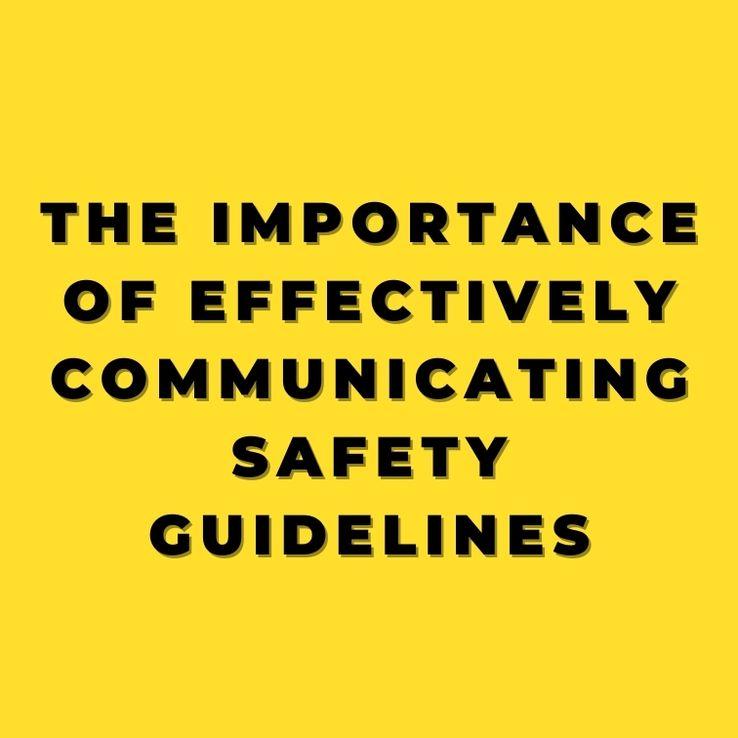In today’s fast-paced and ever-evolving workplace, safety is a top priority. Employers have a responsibility to provide clear and consistent messaging about safety protocols, as well as training for employees on how to stay safe on the job. But simply having safety guidelines in place is not enough. In order to truly create a culture of safety within an organization, employers must actively involve employees in the development of safety procedures. In the following article, I will discuss the importance of effectively communicating safety guidelines and procedures in the workplace. I will explain that employers should provide clear and consistent messaging about safety protocols and provide training for employees on how to stay safe on the job. Additionally, I will explain that nvolving employees in the development of safety procedures and encouraging open communication about safety concerns to create a culture of safety within the organization.
Clear and consistent messaging about safety protocols and training for employees: It is essential that employers provide clear and consistent messaging about safety protocols and procedures to ensure that all employees are aware of the risks and hazards present in the workplace. Employers should also provide training for employees on how to stay safe on the job. This training should cover topics such as proper use of equipment, emergency procedures, and how to recognize and report hazards. By providing clear and consistent messaging and training, employers can empower employees to take an active role in their own safety and the safety of their colleagues. Additionally, it’s important to ensure that all employees receive the same safety training and that training is regularly updated to reflect any changes in safety protocols and procedures. Employers should also make sure that employees understand the training and are able to apply it in practice. This can be done through regular training sessions, assessments, and drills.
Involving employees in the development of safety procedures: Involving employees in the development of safety procedures is an effective way to ensure that all potential hazards and risks are identified and addressed. Employees who work on the frontlines of an organization have a unique perspective on the hazards and risks present in the workplace. By involving employees in the development of safety procedures, employers can gain valuable insight into potential hazards and risks that may have been overlooked. Moreover, involving employees in the development of safety procedures can increase their buy-in and ownership of the safety program. When employees have a hand in creating safety procedures, they are more likely to understand the reasoning behind the procedures and be more invested in following them. Employers can involve employees by conducting surveys, forming safety committees, or holding brainstorming sessions.
Encourage open communication about safety concerns: Encouraging open communication about safety concerns is crucial for creating a culture of safety within an organization. By fostering open and honest communication, employers can ensure that all safety concerns are brought to their attention and addressed in a timely manner. This can be done through regular safety meetings, anonymous reporting systems, or suggestion boxes. Additionally, employers should actively listen to the concerns of their employees and take action to address them. This can be done by following up on reported concerns, conducting investigations, and making necessary changes to safety procedures. Employers should also ensure that employees are aware of the steps that have been taken to address their concerns and that they are kept informed of any changes.
Use various methods to communicate safety guidelines: Employers should use various methods to communicate safety guidelines to ensure that employees are aware of the risks and hazards present in the workplace. This includes providing written materials, conducting training sessions, and incorporating safety messaging into regular meetings. Using different methods of communication will help to reach all employees, regardless of their learning style. For instance, written materials such as safety manual, posters, and brochures can serve as a reference for employees and can be easily accessible. Conducting training sessions will ensure that employees understand the safety procedures and can apply them in practice. Safety messaging can be incorporated into regular meetings to keep safety top-of-mind for employees. Employers should also make sure that the materials and training sessions are translated in the languages that employees speak.
Communicate safety guidelines and procedures regularly: Communicating safety guidelines and procedures regularly is crucial to ensuring that they are top-of-mind for employees. Employers should make sure that safety reminders, periodic training sessions, and regularly scheduled safety meetings are scheduled throughout the year to keep employees informed and aware of any changes to safety protocols. Furthermore, employers should also conduct periodic audits or inspections of the workplace to identify any new hazards or areas for improvement. These audits should be followed and implemented to keep safety at the forefront of employees’ minds. This can help to reinforce the importance of safety and ensure that employees are up-to-date with the latest safety protocols and procedures. One way to communicate safety guidelines and procedures regularly is through safety reminders, such as sending out regular emails or text messages reminding employees of specific safety procedures or hazards to be aware of. Employers can also conduct periodic training sessions to refresh employees’ knowledge and skills on safety procedures. Regularly scheduled safety meetings can also be a good way to communicate safety guidelines and procedures, as well as provide a forum for employees to bring up any safety concerns they may have.
In conclusion, effectively communicating safety guidelines and procedures in the workplace is essential for ensuring the safety of employees. Employers should provide clear and consistent messaging about safety protocols, involve employees in the development of safety procedures, and encourage open communication about safety concerns to create a culture of safety within the organization. Employers should also use various methods to communicate safety guidelines and ensure that safety guidelines and procedures are communicated regularly to keep them top-of-mind for employees. With effective communication and a culture of safety, employers can create a safe and secure workplace for all.










